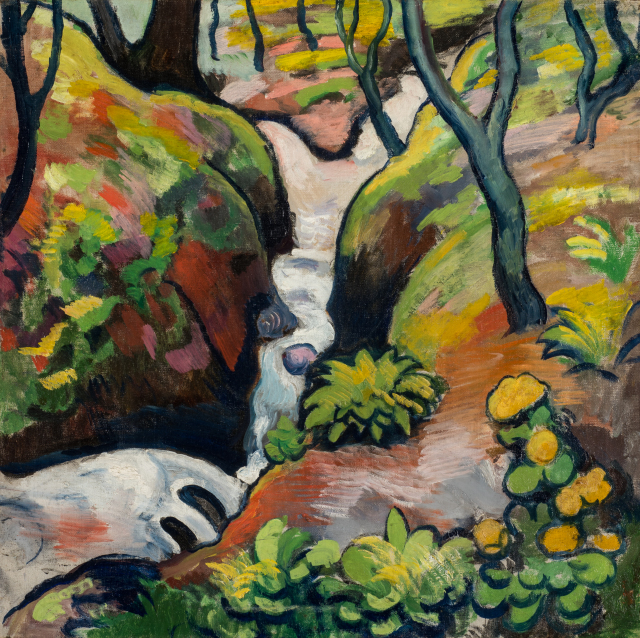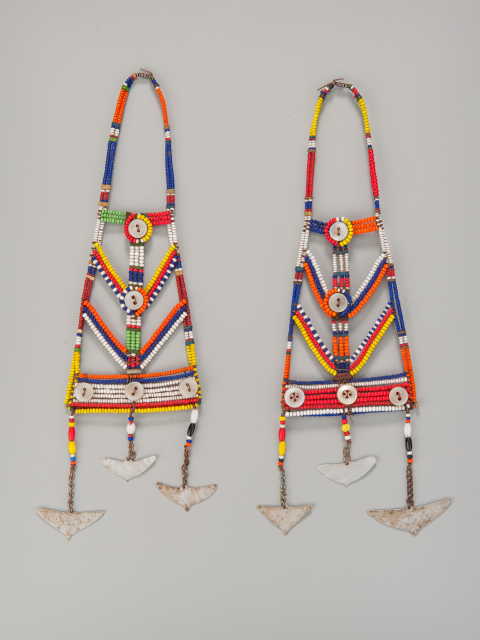Pairing Art and Music
Although we may typically approach art objects through the act of looking, listening offers a surprising and impactful way to engage with the Eskenazi Museum’s diverse collection. This pathway encourages us to blend our auditory and visual senses as we explore an assortment of art objects through music. Along the way, we will see how artists translate music into visual mediums as well as how art of any kind can be seen and heard. In addition to object descriptions, this pathway provides gallery-goers with activities, music, questions, and thinking strategies that center the act of listening to enliven our artistic encounters.
Mask for the Sande Society
READ: Masked dancers perform at masquerades, events that join visual, performative, and musical components and are oftentimes endowed with spiritual significance. In Mende culture in Sierra Leone, women dancers of the Sande society, known as ndoli jowei, perform with sowei masks like this one at births, funerals, and rites-of-passage. While the date of this mask is unidentified, museum collections often situate sowei masks in the 19th or 20th century, and the Sande society remains part of Mende culture today.
During masquerades, these masks are experienced alongside the dancer's ensemble, movements, music and other paraphernalia. The ndoli jowei wears a full-body black fiber costume beneath a long raffia cape draped with bells that chime as she moves. Segbura (gourds filled with seeds encased in a netting sewn with more seeds) and sangbei (a wooden, upright, hollow-body drum) accompany the dancer as she performs quick and intricate footwork.
LISTEN: To experience these performances, we invite you to watch this video of a Sande society masquerade, filmed by curator Paul Basu and The Light Surgeons for a 2013 exhibition at the British Museum. As you watch and listen, consider what sounds you can identify.
WONDER: What connection do you notice between the music and the masquerader's ensemble and dancing?
Red-Figure Mixing Bowl (Column-Krater) with Symposium Scene and Gymnasium Scene
READ: Music was an essential component of social and cultural life in Ancient Greece. Musicians performed at religious ceremonies, oral recitations, and symposia. Symposia, like that represented here, were social events where citizens would gather for food, wine, music, and entertainment.
The artist depicts three instruments—two lyres (one hanging and one in the hands of the far-right figure) and an aulos. The lyre is a stringed musical instrument comprised of two arms connected by a crossbar and a bottom tailpiece around which the strings are wound. The lyre often appears as an attribute of the Greek god Apollo, inventor of string-music, and symbolizes wisdom and moderation. The aulos, played by the central figure, is a flute-like wind instrument typically associated with the satyr, Marsyas. In Ovid’s Metamorphoses, Marsyas challenges Apollo to a musical competition wherein Marsyas loses and is ultimately punished. In ancient Greece, instrumental music often accompanied sung recitations of such poetic verses.
LISTEN: Listen to a performances by musician Theodore Koumartzis and ancient music historian Stefan Hagel.
WONDER: How would you describe their sounds? Which instrument would you prefer to play?
Hexagonal Censer
a capella voicing chanting.
LEARN: Eastern Orthodox ceremonies such as The Holy Eucharist often entail a multi-sensory experience that includes altarpieces, wine (no. 8), bread (no. 7), incense (no. 9), and music. Music in the form of chanting is and was an essential part of Christian Orthodox ceremonies. More than simply communicating prayers, chanting enhances the congregation’s sense of connection with the divine. Historically, cantors (or singers) filled the church's open architecture with powerful, reverberating sounds that the congregation could hear and feel.
LISTEN: As you look at this censor, listen to a Greek Byzantine Orthodox Chant: Agni Parthenean.
WONDER: How does the sound effect your experience of this object?
Swing Landscape
[jazz piano]
LEARN: In Stuart Davis's Swing Landscape, bold colors and abstract shapes represent waterfront imagery based on the docks of Gloucester, Massachusetts. Inspired in part by swing, a type of jazz, Swing Landscape evokes the rhythm and feeling of this musical genre through its energized and improvisational organization of space, shapes, and colors. Davis was particularly fond of the American jazz pianist and bandleader Earl "Fatha" Hines (1903-1983). As one of the most influential American jazz pianists, Hines is remembered for his distinctive "trumpet style" which evoked the brassy, oftentimes rapid stylings of a jazz horn player.
LISTEN: As you view Swing Landscape, try listening to Hines's live performance of 'April Showers' from the 2021 album Keep Moving.
Wonder: How does Hines's performance compare to what you see in Swing Landscape? Does Swing Landscape evoke the style of jazz music or does another musical genre come to mind?
Artist(s):
Stuart Davis (American, 1892–1964)
Title:
Swing Landscape
Date:
1938
Medium(s):
Oil on canvas
Dimensions:
86 3/4 × 173 1/8 in.
Accession Number:
42.1
Credit Line:
Allocated by the U.S. Government, Commissioned through the New Deal Art Projects, Eskenazi Museum of Art, Indiana University
Location:
Eskenazi Gallery, European and American Art, Modern and Contemporary, Henry Radford Hope Wing, 1st Floor
Listen to 'April Showers' one time through. Then, using a pencil and paper (available at the Welcome Center) draw your own jazz-inspired abstract artwork. If you need help getting started, consider these tips:
> Draw what you feel! What emotions or memories does 'April Showers' evoke for you? Try imagining those feelings in visual terms (line, shape, texture, value) and drawing them.
> Start with something real! Pick a person or thing from real life and try representing it in an abstract way. If you choose a person, what shape might represent them? Are the lines of that shape jagged, soft, or something in between? If you select an object, how might you simplify that object and draw it using one or two shapes or lines?
> Start with space! Try dividing the page into segments or use lines and shapes to start organizing the space of your composition.
> Let there be doodles! Let your hand draw automatically or try doodling without lifting your pencil from the page.
> Forget the pencil! Let the paper be your medium by folding, crumpling, or twisting it into an abstract form.
Suggested Pathways

Mindfulness
The series of audio entries on this pathway focus on the practice of mindfulness. Mindfulness is a way of observing and accepting the present moment. It can be especially effective when used while experiencing works of art.

Clothing and Personal Adornment
This path considers how and why human beings create art for personal use. Clothing, jewelry, cosmetics, hair styles and hair accessories, and other objects added to the body are personal statements that also reflect shared values within societies.

